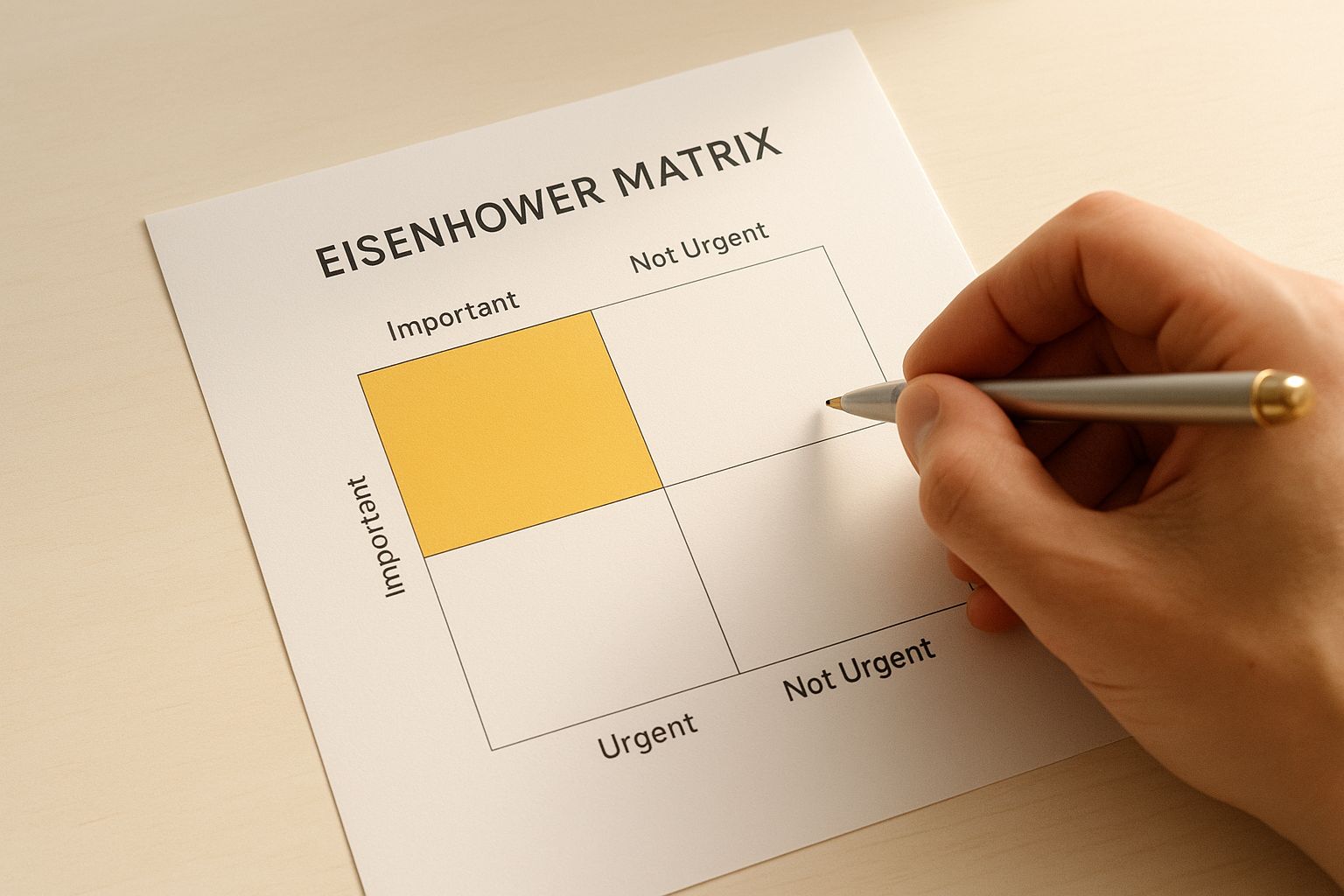Understanding the Psychology Behind Task Overload

Let's be honest, a never-ending to-do list can feel incredibly overwhelming. This feeling isn't just about the number of tasks; it's deeply connected to how our minds work. Our brains, while amazing, aren't built to effortlessly manage countless competing priorities. This section explores why task overload is so mentally draining, and how understanding these psychological roadblocks is the first step towards effective prioritization.
Why Your Brain Resists Prioritization
One major reason we struggle to prioritize is decision fatigue. Every decision, big or small, uses mental energy. A long list of tasks can make deciding what to do first exhausting, which often leads to procrastination. We avoid making those tough choices.
Our brains also crave instant gratification. We're drawn to easier, quicker tasks, even if they're less important long-term. This creates a cycle of finishing low-impact tasks while critical, high-impact ones get pushed aside. For more insights, check out this article on How to master interruption management.
The Importance of Value Alignment
Prioritization is also tied to our values and sense of purpose. If we don't see a task's value or how it contributes to our goals, it's harder to prioritize. This is especially true in the Australian workplace.
Employee engagement trends in Australia highlight the importance of aligning tasks with employee values. While 84% of Australian employees are motivated to exceed expectations, engagement scores are below global averages. This suggests that even though employees are willing to put in the effort, they need to feel valued and supported. You can explore this further in Five Employee Engagement Trends in Australia. This disconnect between effort and impact fuels frustration and burnout, making prioritization even harder.
Thinking Like a Productivity Pro
Successful professionals understand this prioritization psychology. They know effective task management isn't just about checking things off; it's about consciously choosing where to focus energy. They approach prioritization strategically, aligning tasks with their overall goals and values.
By understanding these psychological factors, we can shift from reacting to our to-do lists to proactively managing them. This lays the groundwork for developing sustainable systems and using tools that genuinely improve our productivity.
Battle-Tested Methods That Actually Work in Practice

This infographic showcases the Eisenhower Matrix, a popular task prioritization method. The labeled quadrants and the hand poised to categorize a task visually represent the core principle: separating tasks based on urgency and importance. The image clearly demonstrates how the Eisenhower Matrix offers a straightforward visual framework for quickly sorting tasks, prompting you to consider both urgency and importance as you make decisions.
Having a to-do list isn't enough; you need a system. This section explores proven task management frameworks, including the Eisenhower Matrix, Getting Things Done (GTD), and the ABCDE Method. We'll help you choose the best fit for your individual work style.
The Eisenhower Matrix: Urgent vs. Important
The Eisenhower Matrix, also called the Urgent-Important Matrix, helps categorize tasks into four quadrants:
- Do First: Urgent and important (e.g., deadlines, crises).
- Schedule: Important but not urgent (e.g., planning, relationship building).
- Delegate: Urgent but not important (e.g., interruptions, some meetings).
- Eliminate: Neither urgent nor important (e.g., time-wasting activities, busywork).
This method is great for visual learners and helps break down the feeling of being overwhelmed by a long to-do list.
Getting Things Done (GTD): Capture and Clarify
GTD centers around capturing all your tasks in one location and then clarifying their next action steps. This system involves five key stages:
- Capturing: Gathering all your tasks, ideas, and commitments.
- Clarifying: Processing what each item means and deciding the next required action.
- Organizing: Putting tasks into appropriate lists (e.g., projects, next actions).
- Reflecting: Regularly reviewing your system for optimal performance.
- Engaging: Choosing what to work on based on context, available time, and energy levels.
GTD offers a comprehensive approach but can require a significant initial time investment to implement.
The ABCDE Method: Prioritized Action Steps
The ABCDE Method assigns a letter to each task, indicating its level of importance:
- A: Very important tasks with serious consequences.
- B: Important tasks but with milder consequences.
- C: Tasks with no real consequences.
- D: Tasks to delegate to others.
- E: Tasks to eliminate entirely.
You can further prioritize within each letter by numbering tasks (A1, A2, etc.). This method is simple and encourages immediate focus on the most crucial tasks.
To understand these methods better, let's compare them side-by-side:
Comparison of Popular Task Prioritisation Methods
A comprehensive comparison of the most effective prioritisation frameworks, including complexity, time investment, and best use cases
| Method | Complexity Level | Time to Learn | Best For | Key Benefits |
|---|---|---|---|---|
| Eisenhower Matrix | Simple | Low | Visual Learners, Quick Decisions | Easy visualization, reduces overwhelm |
| Getting Things Done (GTD) | Complex | High | Comprehensive Task Management | Thorough system, improves clarity |
| ABCDE Method | Simple | Low | Fast-Paced Environments | Rapid prioritization, action-oriented |
This table summarizes the key differences between these popular methods, highlighting their complexity, learning curve, and ideal use cases. Choosing the right method depends on your specific needs and preferences.
Choosing the Right Method for You
There’s no one-size-fits-all solution for task prioritization. Consider your personality, work environment, and the nature of your work. If you’re a visual learner, the Eisenhower Matrix might be a great starting point. For those in fast-paced industries like real estate, the ABCDE Method's rapid prioritization might be beneficial. You might be interested in: How to master time management for real estate agents. Experiment to find the system that consistently helps you prioritize tasks and achieve your goals. Remember, prioritizing tasks is an ongoing process of evaluating and adjusting based on your current needs and circumstances.
Creating Boundaries That Protect Your Personal Time

True work-life balance isn't about drastically cutting back your hours; it's about smart prioritization. It's about creating a sustainable rhythm between your professional life and your personal commitments. This section explores how successful professionals in Australia achieve this balance and protect their personal time.
Distinguishing Between Urgent and Important
Many of us react to what feels urgent, often overlooking truly important tasks that lack immediate deadlines. Recognizing the difference between these two is key. Urgent tasks demand immediate attention, often driven by external pressures. Important tasks contribute to your long-term goals and values.
Think of it this way: answering a ringing phone is urgent; strategizing your career progression is important. Responding to a client's urgent email is critical, but planning your weekly business development, while important, might not carry the same immediate weight. This distinction allows you to make informed decisions about your time and energy.
Communicating Your Priorities
Once you've pinpointed your priorities, communicating them to your colleagues and managers is essential. This transparency helps manage expectations and minimizes disruptions. Clearly communicating your current focus allows others to understand your availability and respect your dedicated work blocks. It also fosters collaboration and support in managing shared responsibilities.
Prioritization is vital for employee engagement and retention in Australia. Work-life balance is a top priority for Australian employees, with flexible work options and family-friendly policies being key factors. Find more detailed statistics here. Employers who prioritize these aspects cultivate a more supportive environment.
The Power of "No"
Strategically saying "no" is a powerful tool for protecting your time. This doesn't mean rejecting everything, but carefully considering whether a new task aligns with your priorities and capacity. Respectfully explaining your reasoning strengthens professional relationships while safeguarding your time. This ensures you can dedicate your full attention to the tasks that truly matter, both professionally and personally.
Building a Sustainable System
Creating boundaries isn't a one-time fix; it's an ongoing process. Scheduling dedicated personal time, just like a work meeting, reinforces its importance. This might mean blocking out evenings for family, scheduling weekend activities, or setting aside 30 minutes daily for exercise or relaxation.
Integrating these practices into your routine reinforces the value of your personal time and creates a more balanced life. This consistent effort will ultimately lead to increased productivity and overall well-being.
Triage Techniques for Overwhelming Workloads
When deadlines loom and your to-do list seems endless, deciding where to start can be overwhelming. Many Australian professionals struggle with this, juggling demanding workloads. This section provides triage techniques to quickly assess task importance, negotiate deadlines, and break down complex projects into manageable steps. We'll also explore maintaining quality under pressure and managing stress when priorities clash.
Rapid Task Assessment: The Triage Approach
Imagine a hospital emergency room. A triage system helps medical professionals quickly assess the urgency and importance of each patient's condition. Apply this same principle to your overflowing inbox, looming deadlines, and ringing phone. Where do you begin?
-
Identify Must-Dos: First, pinpoint the absolute must-do tasks. These are time-sensitive and have significant consequences if not completed. Think of a critical client presentation or a crucial report for your manager.
-
Delegate or Defer: Next, determine which tasks can be delegated to a colleague or postponed. Perhaps a junior team member can draft initial reports, or a non-urgent meeting can be rescheduled. This frees up your time for more critical tasks.
-
Eliminate Time-Wasters: Finally, be honest about tasks that are simply time-wasters. These could be unnecessary meetings, low-priority emails, or tasks no longer contributing to your goals. Eliminating these creates space in your schedule.
This rapid assessment helps you focus on what truly matters, making decisive choices when faced with competing demands.
Negotiating Deadlines and Managing Expectations
Sometimes, despite our best efforts, deadlines are simply unrealistic. This requires proactive communication and negotiation with stakeholders. Clearly explaining your current workload and suggesting adjusted deadlines prevents misunderstandings and maintains professional relationships. It’s about finding solutions that work for everyone.
For example, if facing a tight deadline on a complex project, break it into smaller milestones with interim deadlines. This demonstrates progress and manages expectations. It's far better to proactively adjust deadlines than to miss them entirely.
Breaking Down Complex Projects: The Power of Chunking
Large, complex projects can be daunting. The key is to break them down into smaller, manageable chunks. This makes the overall project less intimidating, allowing you to focus on one step at a time. Think of writing a lengthy report. Instead of feeling overwhelmed by the entire document, break it down into sections: introduction, literature review, methodology, results, discussion, and conclusion. Each section becomes a mini-project with its own deadline.
This chunking technique not only helps with prioritization but also improves focus and motivation. Completing these smaller chunks provides a sense of accomplishment.
Maintaining Quality Under Pressure
Even with heavy workloads, maintaining quality is essential. One strategy is the Pareto Principle, also known as the 80/20 rule. This principle suggests that roughly 80% of your results come from 20% of your effort. Identify that 20% of your work with the greatest impact and focus your energy there.
This doesn’t mean neglecting the remaining 80%, but being strategic about where you invest your peak performance. It’s about working smarter, not harder.
Stress Management for Conflicting Priorities
Conflicting priorities are inevitable. Building resilience and developing stress management techniques is crucial. This might involve mindfulness practices, regular breaks, or activities that help you disconnect and recharge. Prioritizing your well-being helps you navigate demanding workloads sustainably.
Building Systems For Sustainable Productivity Success
Sustained productivity isn’t about pushing yourself to the limit; it's about creating systems that consistently deliver without constant mental strain. This means developing habits and workflows that automatically support effective prioritization, rather than relying solely on willpower. Think of it like setting up a household budget – once the system is in place, managing your finances becomes less stressful and more automatic.
Designing Your Environment For Success
Your environment plays a vital role in your ability to prioritize tasks. A cluttered workspace can lead to a cluttered mind, making it difficult to focus on what's important. Creating a designated workspace, free from distractions, can significantly improve your focus and decision-making. This could be as simple as tidying your desk or establishing a dedicated home office.
You might also want to explore automating repetitive tasks. This can free up mental space for more strategic work. Check out this resource: How to master business process automation.
Automating Routine Choices
Many prioritization decisions are routine and predictable. Consider automating these choices to streamline your workflow. For example, use email filters in Gmail or other email clients to automatically categorize incoming messages based on their importance. Schedule specific times for checking social media or responding to emails to avoid constant interruptions. This lets you dedicate focused blocks of time to your high-priority tasks.
Creating templated responses for common emails can also save valuable time, allowing you to focus on tasks requiring more in-depth thought.
Accountability And Support Structures
Accountability is essential for maintaining productivity systems. This might involve sharing your goals with a colleague, joining a productivity group, or using a task management app like Asana with reminder features. Effective task management is vital for navigating workforce dynamics, particularly regarding employee retention. Learn more about this topic.
Regularly reviewing and adjusting your systems is also crucial for long-term success. This ensures your systems remain aligned with your evolving goals and responsibilities.
Adapting To Change And Challenges
Life is full of unexpected events. Successful professionals build flexibility into their systems. This could involve having a backup plan for when your usual routine is disrupted, or developing strategies for re-prioritizing tasks when unexpected challenges arise. Think of it like having a spare tire – you hope you never need it, but it's invaluable when you do. This proactive approach helps maintain productivity even during unforeseen disruptions. Remember, prioritization is a skill developed and refined over time; the goal is continuous improvement, not perfection.
Digital Tools That Enhance Rather Than Complicate
The right digital tools can significantly boost your task prioritization, but choosing the wrong ones can lead to digital clutter and reduced productivity. This section offers a practical look at effective apps and platforms, ranging from simple task managers to comprehensive project management suites, designed for the Australian professional.
Finding the Right Fit: Avoiding Tool Overwhelm
The sheer volume of productivity apps available can be daunting. Before you start exploring, consider your specific needs and work style. Are you working independently or as part of a team? Do you need basic task lists or more complex project management functionalities?
-
Simple Task Managers: For individuals managing personal tasks, apps like Todoist or Microsoft To Do offer easy list creation, due dates, and reminders. These are perfect for staying on top of daily errands, appointments, and personal projects.
-
Collaborative Project Management Software: For teams, platforms like Asana, Trello, or Monday.com offer shared workspaces, task assignments, progress tracking, and communication features. These are ideal for managing projects involving multiple people.
-
Integrated Suites: Many Australians already use Google Workspace or Microsoft 365. These suites often include task management and calendar features that integrate with other apps like email and cloud storage. Using these existing tools can be more efficient than adding a new, separate application.
To help you choose the right tool, we've compiled a comparison of popular options:
The following table provides a detailed breakdown of popular task management tools and their suitability for different needs:
Top Task Management Tools for Australian Professionals
| Tool Name | Key Features | Pricing (AUD) | Best For | Integration Options |
|---|---|---|---|---|
| Todoist | Task creation, due dates, reminders, collaboration | Free, Premium plans available | Individuals, small teams | Wide range of integrations via Zapier |
| Microsoft To Do | Task lists, reminders, sharing | Free | Individuals, small teams | Integrates with Microsoft 365 suite |
| Asana | Project management, task assignment, progress tracking, communication | Free, Paid plans for additional features | Teams, projects | Integrations with various other apps |
| Trello | Kanban boards, task management, collaboration | Free, Paid plans for more features | Visual project management, teams | Integrates with many other tools |
| Monday.com | Customizable workflows, automation, collaboration | Paid plans | Teams, complex projects | Extensive integration options |
| Google Workspace (Tasks) | Basic task management, integration with other Google services | Included with Google Workspace subscription | Google users, simple task management | Seamless integration within Google Workspace |
| Microsoft 365 (To Do) | Task management, integration with Microsoft apps | Included with Microsoft 365 subscription | Microsoft users, basic task management | Deep integration within Microsoft 365 |
As you can see, various options cater to different needs and budgets. Consider your individual or team requirements when making your selection.
Maximising Value: Configuration and Integration
Once you’ve chosen a tool, configure it to align with your prioritization methods. For example, if you use the Eisenhower Matrix, create categories or tags for "Urgent," "Important," "Delegate," and "Eliminate." This simplifies using the system within your chosen tool.
Think about how your tool integrates with other systems. Many apps offer Zapier integrations, connecting different tools to automate workflows. For example, automatically create a task in your project management software when you receive a specific email.
Warning Signs: When a Tool Isn't Working
Sometimes, even the best technology can hinder productivity. Here are some signs that it might be time to re-evaluate:
- Data Entry Overload: Spending more time managing the tool than completing tasks.
- Lack of Consistency: Constantly switching between tools or reverting to old habits.
- Poor Team Adoption: Low usage within a team suggests the tool isn’t meeting their needs.
Automating Routine While Maintaining Flexibility
Effective professionals use technology to automate routine decisions, like calendar reminders for recurring deadlines, automated email filters, or recurring tasks for weekly reports. This frees up mental capacity for complex decisions.
However, flexibility is key. Your tools should support your system without being rigid. The ability to adjust deadlines, re-prioritize, and accommodate unexpected events is essential.
Your Step-by-Step Implementation Action Plan
Knowledge without action is like a toolbox full of unused tools. This section offers a practical, step-by-step plan to implement effective task prioritization, designed to deliver immediate results. You'll explore daily and weekly routines, troubleshooting common roadblocks, and benchmarks for measuring your progress.
Starting Small, Thinking Big
Begin by making manageable changes. Don't attempt to overhaul your entire system overnight. Instead, select one technique from this blog post and integrate it into your daily routine. For example, try using the Eisenhower Matrix for one week. Focus on identifying and eliminating your "Not Important" tasks. This approach lets you experience the benefits of prioritization without feeling overwhelmed.
Your Daily Prioritization Routine
-
Morning: Set aside the first 15-30 minutes of your day to prioritize. This might include reviewing your to-do list, pinpointing your top three most important tasks, and scheduling dedicated time blocks for focused work. Just like prioritizing saving money, tackle tasks that directly contribute to your own goals before addressing tasks for others. Some productivity experts refer to these as your "TOMs" (Tasks of Mine) versus your "TOTOs" (Tasks of Theirs).
-
Throughout the Day: Re-evaluate your priorities as needed. New tasks will inevitably pop up, so be prepared to adjust your schedule accordingly. Use the triage techniques discussed earlier to quickly assess the importance and urgency of incoming requests.
-
Evening: Briefly review your accomplishments and fine-tune your plan for the following day. This helps maintain momentum and ensures you start each day with a clear focus.
Your Weekly Review: Staying on Track
-
Weekend Planning: Block out 30 minutes each weekend to review the past week and plan for the upcoming one. Analyze what was effective, what needs improvement, and adjust your prioritization system as needed. Reflect on your achievements and identify any recurring challenges.
-
Long-Term Goals Alignment: Ensure your weekly priorities are in sync with your broader career and personal goals. This keeps your daily tasks focused and purposeful, echoing Stephen Covey's famous advice: "The key is not to prioritize what's on your schedule, but to schedule your priorities."
Troubleshooting Common Challenges
-
Motivation Dips: We all experience periods of low motivation. During these times, concentrate on small, achievable wins to regain momentum. Even completing a few minor tasks can boost your motivation and get you back on course.
-
Unexpected Disruptions: Life is full of surprises. Develop a backup plan for handling unforeseen events. This could involve maintaining a flexible schedule or incorporating designated "buffer" time to accommodate urgent requests.
-
Procrastination: If you're prone to procrastination, try breaking down large tasks into smaller, more manageable steps. This makes the overall project seem less daunting and easier to begin.
Measuring Progress and Adapting
Regularly review your accomplishments to track your progress. Are you consistently completing your high-priority tasks? Are you feeling less stressed and more in control? This provides valuable feedback and allows you to refine your approach. As your responsibilities change, adapt your prioritization system to meet your current needs. Remember, the goal is continuous improvement, not perfection.
Ready to transform how you manage calls and reclaim valuable time? OnSilent is a smart voicemail and call management solution built for busy professionals. Reclaim up to eight hours per week by streamlining your communications. Learn more and start your free trial at OnSilent.

